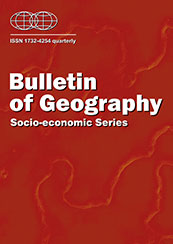An analysis of the spatial distribution, influence and quality of urban green space – a case study of the Polish city of Tczew
An analysis of the spatial distribution, influence and quality of urban green space – a case study of the Polish city of Tczew
Author(s): Adam Senetra, Iwona Krzywnicka, Marcin MielkeSubject(s): Geography, Regional studies, Energy and Environmental Studies, Rural and urban sociology, Environmental interactions, Tourism, Transport / Logistics
Published by: Wydawnictwo Naukowe Uniwersytetu Mikołaja Kopernika
Keywords: city; green space; availability; distribution; Green-Space Record;
Summary/Abstract: Rapid urban growth can exert negative effects on the natural environment due to the loss of naturally vegetated areas, loss of biological diversity, deforestation and soil erosion. The condition of cities is inherently linked with the natural environment which has a positive influence on health, social relations, human welfare and economic activity. Urban areas should abound in green spaces, and should also be easily accessible to the general public. The aim of this study was to determine the spatial distribution, influence and quality of urban green spaces on the example of the city of Tczew in northern Poland. The proposed methodology can be applied in cities of a similar size and urban structure to promote rational management of urban green space in line with the principles of sustainable development and spatial order. The Green-Space Record, a useful tool for inventorying urban green spaces, was developed to pursue the main research goal. The information accumulated in the Record constitutes valuable input data for further analysis, including the determination of the area, distribution, influence and quality of urban green spaces. The results of the analysis revealed that urban green spaces occupy more than 19% of Tczew’s territory, which is equivalent to 70.6 m2 per resident. Managed green spaces span the area of only 66.75 ha (11.31 m2 per resident) and are unevenly distributed in the city. More than half of these areas are found in the Stare Miasto (Old Town) district, whereas two residential districts (Gdańska, Prątnica) are completely devoid of public greens. The quality of urban green spaces is generally satisfactory in Tczew; however, not all residents have equal access to high-quality public greens.
Journal: Bulletin of Geography. Socio-economic Series
- Issue Year: 2018
- Issue No: 42
- Page Range: 129-149
- Page Count: 21
- Language: English

